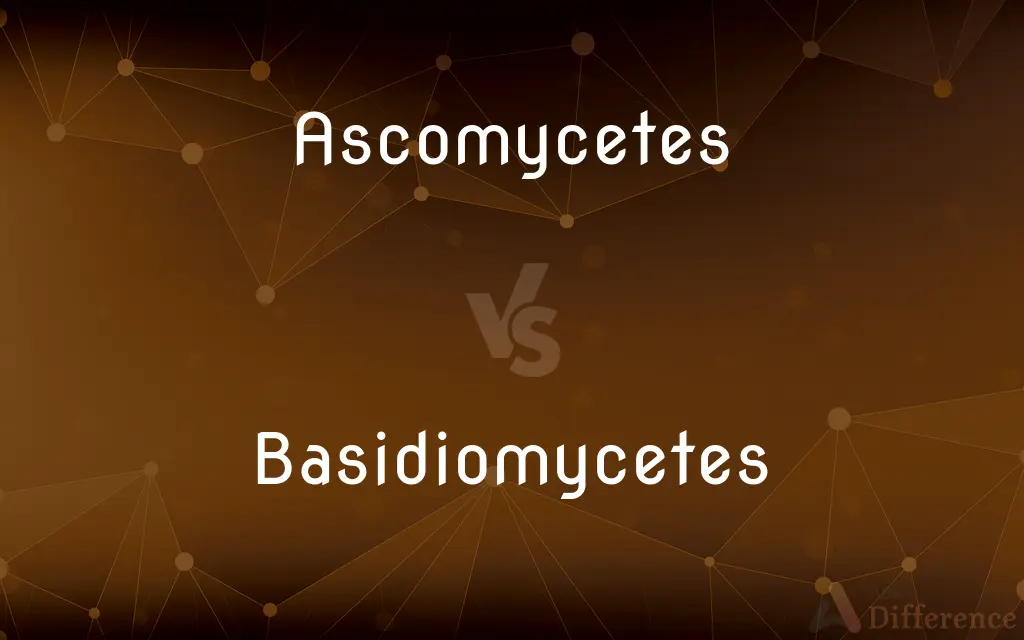Ascomycetes vs. Basidiomycetes — What's the Difference?
By Fiza Rafique & Urooj Arif — Updated on March 21, 2024
Ascomycetes produce spores in sac-like structures called asci, while Basidiomycetes form spores externally on basidia.

Difference Between Ascomycetes and Basidiomycetes
Table of Contents
ADVERTISEMENT
Key Differences
Ascomycetes and Basidiomycetes are two major classes of fungi, distinguished by their reproductive structures and mechanisms. Ascomycetes, also known as sac fungi, are characterized by the production of spores in specialized sacs called asci. These fungi are diverse, including yeasts, molds, and more complex species like morels and truffles. On the other hand, Basidiomycetes, known as club fungi, produce their spores externally on structures called basidia. This group includes mushrooms, puffballs, and bracket fungi, noted for their more conspicuous fruiting bodies.
Ascomycetes reproduce both sexually and asexually, with the asexual phase often resulting in the production of conidia, which are spores produced at the tip of specialized hyphae. The sexual phase culminates in the formation of asci within fruiting bodies such as morels or cup fungi. Basidiomycetes, while they can have a form of asexual reproduction, are primarily known for their sexual reproduction, leading to the formation of basidia on the gills or pores of mushrooms, where spores are then released into the environment.
The ecological roles of Ascomycetes and Basidiomycetes vary, but both are crucial for their environments. Ascomycetes are often decomposers, pathogens, or involved in symbiotic relationships, such as lichens (a partnership between a fungus and an algae or cyanobacterium) and mycorrhizae (a symbiotic association with plants). Basidiomycetes are primarily known for their role in decomposing wood and other plant material, facilitating nutrient cycling in ecosystems.
The diversity within Ascomycetes is immense, with estimates of tens of thousands of species ranging from unicellular yeasts to complex multicellular forms. This group is responsible for many beneficial processes, including fermentation in bread, beer, and wine production, as well as for some diseases in plants and animals. Basidiomycetes, though fewer in species number, include some of the most familiar fungi, such as the common mushroom and the fly agaric. Their complex life cycles and large, often edible fruiting bodies have made them subjects of both culinary interest and scientific study.
Fruiting bodies of Ascomycetes and Basidiomycetes also differ significantly. Ascomycetes produce a variety of fruiting bodies, such as the delicate cups of Peziza or the truffles that grow underground. Basidiomycetes produce larger, more recognizable structures like mushrooms, which are often seen after rain. These differences in fruiting bodies are reflective of their differing ecological niches and reproductive strategies.
ADVERTISEMENT
Comparison Chart
Reproductive structure
Asci
Basidia
Spore production
Internally in asci
Externally on basidia
Reproduction
Both sexual and asexual
Primarily sexual, some asexual
Examples
Yeasts, molds, truffles
Mushrooms, puffballs, bracket fungi
Ecological roles
Decomposers, pathogens, symbionts
Decomposers, especially of wood
Compare with Definitions
Ascomycetes
A group of fungi characterized by spores formed in asci.
The yeast used in brewing and baking is an ascomycete.
Basidiomycetes
Fungi that produce spores on external structures called basidia.
The common mushroom found in forests is a basidiomycete.
Ascomycetes
Can produce valuable substances like antibiotics.
The ascomycete Penicillium produces the antibiotic penicillin.
Basidiomycetes
Known for edible and poisonous species.
The edible portobello mushroom and the poisonous fly agaric are both basidiomycetes.
Ascomycetes
Responsible for certain plant diseases.
The ascomycete fungus causes powdery mildew on leaves.
Basidiomycetes
Some species are important for their symbiotic relationships with trees.
Basidiomycetes form mycorrhizal associations with forest trees.
Ascomycetes
Known for diverse fruiting bodies, including cups and truffles.
Truffles, a delicacy, are the fruiting bodies of certain ascomycetes.
Basidiomycetes
Play a critical role in decomposing wood and organic matter.
Shelf fungi decomposing a log are basidiomycetes.
Ascomycetes
Includes species that form symbiotic relationships, like lichens.
Many lichens covering trees and rocks are formed by ascomycetes.
Basidiomycetes
Includes fungi with large, easily recognizable fruiting bodies.
Puffballs, which release spores when pressed, are basidiomycetes.
Ascomycetes
Any of numerous fungi of the division Ascomycota, characterized by the presence of haploid spores formed within an ascus, and including truffles, morels, and many food molds. Also called sac fungus.
Basidiomycetes
Any of various members of a large group of fungi producing spores on basidia. The group includes puffballs, shelf fungi, rusts, smuts, and many species of mushrooms.
Ascomycetes
Plural of ascomycete
Basidiomycetes
Plural of basidiomycete
Ascomycetes
Large class of higher fungi .
Basidiomycetes
A phylum of fungi with the Basidiomycota
Ascomycetes
A large class of higher fungi distinguished by septate hyphæ, and by having their spores formed in asci, or spore sacs; the sac fungi. It comprises many orders, among which are the yeasts, molds, mildews, truffles, morels, etc. The class is coextensive with the phylum Ascomycota.
Basidiomycetes
Large class of higher fungi coextensive with subdivision Basidiomycota
Ascomycetes
Large class of higher fungi coextensive with division Ascomycota: sac fungi
Common Curiosities
Can both Ascomycetes and Basidiomycetes be edible?
Yes, both groups include edible species, though they must be correctly identified to avoid poisonous varieties.
Are Ascomycetes important for the environment?
Yes, they play key roles as decomposers, pathogens, and in symbiotic relationships.
Do Basidiomycetes have any commercial value?
Yes, many basidiomycetes are cultivated for food, and some have medicinal properties.
Are Basidiomycetes found in symbiotic relationships?
Yes, many form symbiotic mycorrhizal associations with plants, aiding in nutrient uptake.
How are Ascomycetes and Basidiomycetes used in research?
They are studied for their ecological roles, genetic makeup, and potential in biotechnology.
What distinguishes Ascomycetes from Basidiomycetes?
The main distinction lies in their reproductive structures; ascomycetes have asci, while basidiomycetes have basidia.
What role do Basidiomycetes play in nature?
They are crucial for decomposing wood and recycling nutrients in ecosystems.
How do Ascomycetes reproduce?
Ascomycetes reproduce both sexually, through the formation of asci, and asexually, often via conidia.
How can you identify an Ascomycete fungus?
Identification can involve looking for asci or characteristic fruiting bodies like cups or morels.
Can Ascomycetes cause diseases?
Yes, some ascomycetes are pathogens that affect plants, animals, and humans.
Do Ascomycetes and Basidiomycetes have similar life cycles?
Their life cycles differ, especially in their reproductive phases and structures.
Can Basidiomycetes be grown commercially?
Yes, many mushrooms are grown for food and medicinal purposes.
What are the dangers of consuming wild Basidiomycetes?
Misidentification can lead to poisoning, as some basidiomycetes are toxic.
Share Your Discovery

Previous Comparison
Aggregate vs. Ballast
Next Comparison
Eviction vs. ForeclosureAuthor Spotlight
Written by
Fiza RafiqueFiza Rafique is a skilled content writer at AskDifference.com, where she meticulously refines and enhances written pieces. Drawing from her vast editorial expertise, Fiza ensures clarity, accuracy, and precision in every article. Passionate about language, she continually seeks to elevate the quality of content for readers worldwide.
Co-written by
Urooj ArifUrooj is a skilled content writer at Ask Difference, known for her exceptional ability to simplify complex topics into engaging and informative content. With a passion for research and a flair for clear, concise writing, she consistently delivers articles that resonate with our diverse audience.
















































